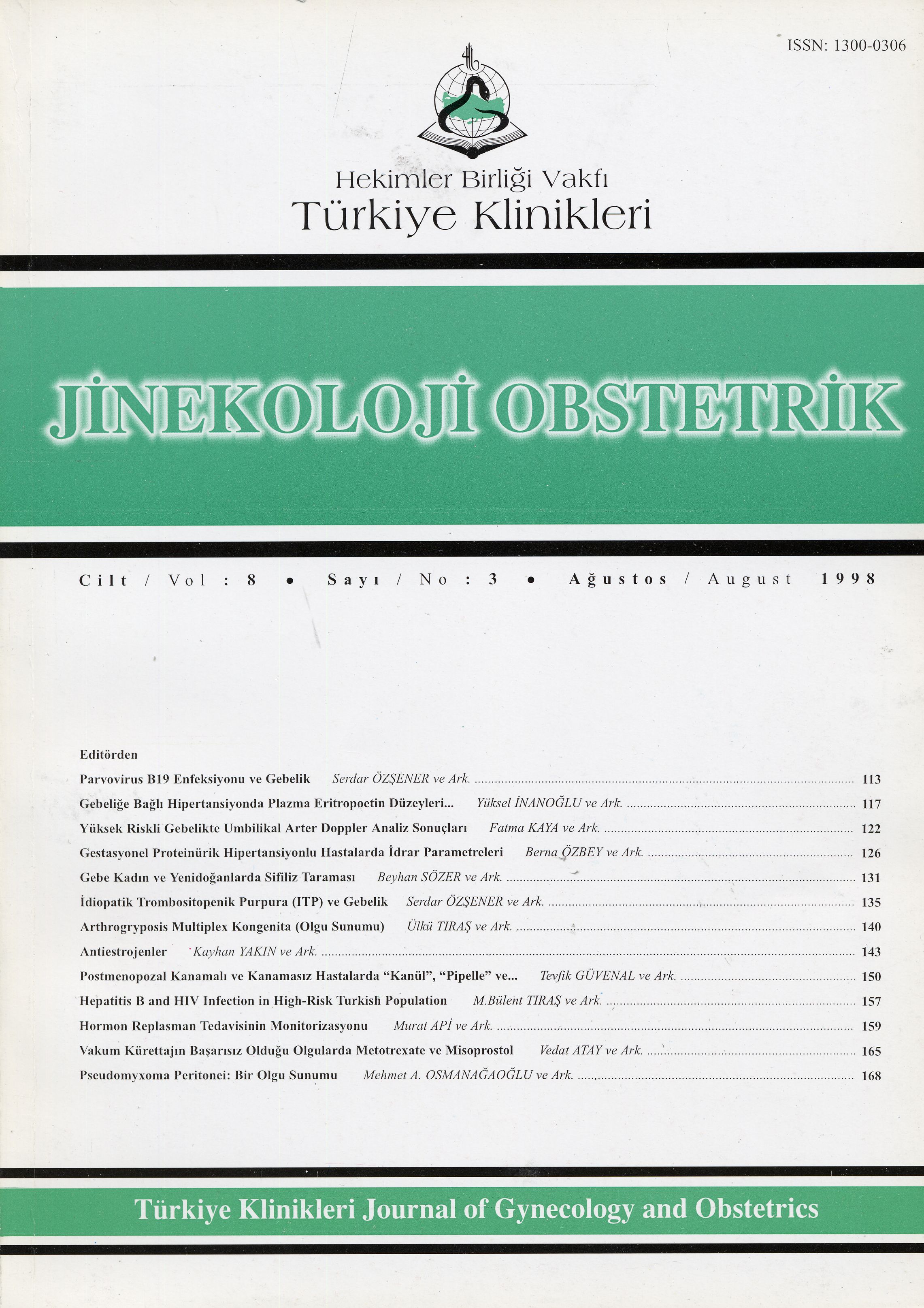Open Access
Peer Reviewed
ARTICLES
3378 Viewed2108 Downloaded
Comparison Of The Canul, Pipelle And Conventionalcurettage Methods Of Endomettrial Sampling Inpostmenopausal Women With And Without Uterine Bleeding
Postmenopozal Kanamalı ve Kanamasız Hastalarda
Turkiye Klinikleri J Gynecol Obst. 1998;8(3):150-6
Article Language: TR
Copyright Ⓒ 2025 by Türkiye Klinikleri. This is an open access article under the CC BY-NC-ND license (http://creativecommons.org/licenses/by-nc-nd/4.0/)
ÖZET
Amaç: Amacımız postmenopozal kadınlarda, üç endometrial örnekleme yönteminin histolojik tanı için yeterli doku elde etmedeki etkinliğini değerlendirmekdi. Materyel ve metod: SSK Göztepe Eğitim Hastanesi Kadın hastalıkları ve doğum polikliniğine başvuran 73ü postmenopoazal kanamalı, 77 asemptomatik, toplam 150 postmenopozal hasta çalışmaya alındı. Her iki grubtaki hastalarda "Kanül", "Pipelle" endometrial aspirasyon ve arkasından lokal anestezi altında probe küretaj (PC) yapıldı. Üç yöntem tanısal doğruluk, histolojik tanı için materyal elde etmedeki yeterlilik ve komplikasyonları açısından karşılaştırıldı. Bulgular: Probe küretaj ile olguların %14ünde başarısızlık olurken, Kanül ve Pipelle ile başarısızlık olmadı. Yeterli materyal elde etme oranı kanül ile %47.1, pipelle ile %43.7, PC ile ise %44 idi. Anestezi verilmeden uygulanan Kanül ve Pipelle hastalar tarafından iyi tolere edildi. Her iki yöntemin doku elde edilmesindeki başarısı küretajdan farklı değildi. Uterus perforasyonu 2 olguda probe küretaj sırasında oluştu Sonuç: Kanül ve pipelle endometrial dokunun histolojik tanısında hızlı, basit, ve ucuz yöntemlerdir. Anestezi gerektirmez,hasta kabulü fazladır ve güvenirliliği yeterli düzeydedir. Bu sonuçlar kanül ve pipellenin postmenopozal kadınlarda klasik küretaj (PC) kadar etkili olduğunu göstermektedir.
Amaç: Amacımız postmenopozal kadınlarda, üç endometrial örnekleme yönteminin histolojik tanı için yeterli doku elde etmedeki etkinliğini değerlendirmekdi. Materyel ve metod: SSK Göztepe Eğitim Hastanesi Kadın hastalıkları ve doğum polikliniğine başvuran 73ü postmenopoazal kanamalı, 77 asemptomatik, toplam 150 postmenopozal hasta çalışmaya alındı. Her iki grubtaki hastalarda "Kanül", "Pipelle" endometrial aspirasyon ve arkasından lokal anestezi altında probe küretaj (PC) yapıldı. Üç yöntem tanısal doğruluk, histolojik tanı için materyal elde etmedeki yeterlilik ve komplikasyonları açısından karşılaştırıldı. Bulgular: Probe küretaj ile olguların %14ünde başarısızlık olurken, Kanül ve Pipelle ile başarısızlık olmadı. Yeterli materyal elde etme oranı kanül ile %47.1, pipelle ile %43.7, PC ile ise %44 idi. Anestezi verilmeden uygulanan Kanül ve Pipelle hastalar tarafından iyi tolere edildi. Her iki yöntemin doku elde edilmesindeki başarısı küretajdan farklı değildi. Uterus perforasyonu 2 olguda probe küretaj sırasında oluştu Sonuç: Kanül ve pipelle endometrial dokunun histolojik tanısında hızlı, basit, ve ucuz yöntemlerdir. Anestezi gerektirmez,hasta kabulü fazladır ve güvenirliliği yeterli düzeydedir. Bu sonuçlar kanül ve pipellenin postmenopozal kadınlarda klasik küretaj (PC) kadar etkili olduğunu göstermektedir.
ABSTRACT
Objective: Our purpose was to compare three endometrial sampling methods to evaluate their ability to obtain sufficient tissue for histologic diagnosis in postmenopausal women. Material and Method: This study ıncluded 150 postmenopausal women admitted at the Department of Obstetrics and Gynecology, in Goztepe Educational Hospital. Of these women 73 had postmenopausal bleeding, and 77 had no symptoms. Endometrial aspirations were performed by using the Canul or Pipelle, followed immediately by the probe curettage (PC) using a sharp curette (Sims ) under local anesthesia in all patients. Results: Diagnostic accuracy, ability to obtain sufficient tissue for histologic diagnosis and complications during sampling of the three methods were compared. Although endometrial sampling could be performed with the canul and pipelle in all patients, twenty-one of 150 cases (%14) could not be performed with PC. Adequate tissue for histological diagnosis was obtained in %47.1 of canul group, %43.7 of pipelle group and %44 of PC group. Canul or pipelle endometrial aspiration, which does not require anesthesia, is well-tolerated by patients.Both the canul and pipelle were not different from probe curettage to obtain endometrial tissue. Two patient had a uterine perforation with probe curettage. Conclusion: Canul and pipelle are quick, simple and cheap methods for histological diagnosis of endometrial tissue. They do not require anesthesia, patient acceptability is high and reliability satisfactory. These results suggest that the canul and pipelle are as efficacious as conventional curettage (PC) in postmenopausal women.
Objective: Our purpose was to compare three endometrial sampling methods to evaluate their ability to obtain sufficient tissue for histologic diagnosis in postmenopausal women. Material and Method: This study ıncluded 150 postmenopausal women admitted at the Department of Obstetrics and Gynecology, in Goztepe Educational Hospital. Of these women 73 had postmenopausal bleeding, and 77 had no symptoms. Endometrial aspirations were performed by using the Canul or Pipelle, followed immediately by the probe curettage (PC) using a sharp curette (Sims ) under local anesthesia in all patients. Results: Diagnostic accuracy, ability to obtain sufficient tissue for histologic diagnosis and complications during sampling of the three methods were compared. Although endometrial sampling could be performed with the canul and pipelle in all patients, twenty-one of 150 cases (%14) could not be performed with PC. Adequate tissue for histological diagnosis was obtained in %47.1 of canul group, %43.7 of pipelle group and %44 of PC group. Canul or pipelle endometrial aspiration, which does not require anesthesia, is well-tolerated by patients.Both the canul and pipelle were not different from probe curettage to obtain endometrial tissue. Two patient had a uterine perforation with probe curettage. Conclusion: Canul and pipelle are quick, simple and cheap methods for histological diagnosis of endometrial tissue. They do not require anesthesia, patient acceptability is high and reliability satisfactory. These results suggest that the canul and pipelle are as efficacious as conventional curettage (PC) in postmenopausal women.
MENU
POPULAR ARTICLES
MOST DOWNLOADED ARTICLES





This journal is licensed under a Creative Commons Attribution-NonCommercial-NoDerivatives 4.0 International License.










